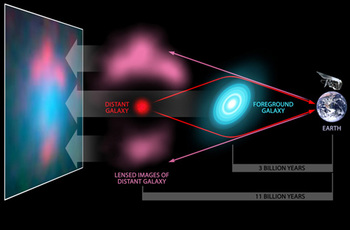
Astronomers estimate that half of the star formation in the universe is obscured by dust—making many distant galaxies in the peak of their star-forming years essentially invisible. But now the invisible has been revealed, thanks to new instruments that can observe in the millimeter, submillimeter, and far-infrared wavelengths in which these galaxies shine. In the November 5 issue of Science, astronomers announce their discovery of five distant, dust-obscured galaxies, magnified by cosmic lenses—galaxies that bend light from a more distant source.
The astronomers noticed the galaxies in images returned by the Herschel Space Observatory, a European Space Agency telescope launched in 2009 to probe the universe in far-infrared and submillimeter wavelengths. Caltech and JPL researchers helped develop Herschel's instruments.
It was a novel Caltech and JPL–designed spectrometer called Z-Spec, on the Caltech Submillimeter Observatory, that revealed the primeval galaxies tucked behind the lenses. Optical telescopes following up on the Herschel data saw only the foreground lensing galaxies.
Z-Spec, which has a bandwidth 10 times bigger than that of other spectrometers for these wavelengths, was able to measure redshifts for four of the five galaxies—the first demonstration that a millimeter-wave spectrometer can consistently provide redshifts for distant galaxies—and confirmed that the light originated when the universe was only two- to four-billion-years old. Z-Spec uses a unique "2-dimensional" spectrometer to realize its large bandwidth while keeping the instrument compact, and is a prototype for an even more capable spectrometer planned for observations in space on the Japanese SPICA far-infrared telescope.

This diagram illustrates a cosmic phenomenon known as gravitational lensing, in which a galaxy magnifies a second, more distant galaxy, making it appear brighter and easier to study. The Herschel Space Observatory turns out to be particularly good at spotting these distant "lensed" galaxies. It has discovered five new ones, and is expected to find many more.
In the diagram, the Herschel telescope and Earth are shown to the right. A foreground galaxy is shown in blue, located approximately three billion light-years away (its light took three billion years to reach us). A more distant galaxy, about 11 billion light-years away, is shown in red. The gravity of the foreground galaxy bends the light from the distant one, as shown with the red lines. The pink lines show what we actually see -- a distorted and magnified view of the distant galaxy. An example of a final image taken by ground-based telescopes is at the far left.
Herschel is a European Space Agency cornerstone mission, with science instruments provided by consortia of European institutes and with important participation by NASA. NASA's Herschel Project Office is based at NASA's Jet Propulsion Laboratory, Pasadena, Calif. JPL contributed mission-enabling technology for two of Herschel's three science instruments. The NASA Herschel Science Center, part of the Infrared Processing and Analysis Center at the California Institute of Technology in Pasadena, supports the United States astronomical community. Caltech manages JPL for NASA.
See the website for more details.
http://www.cso.caltech.edu/outreach/kiosk/news2010/zspec_press/index.html(SY)
